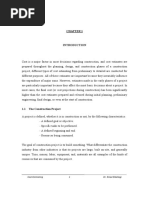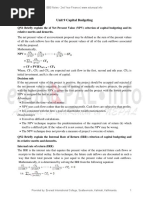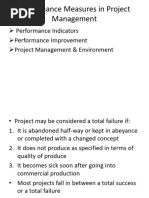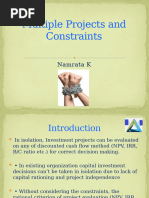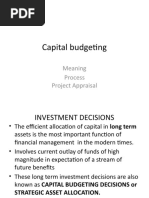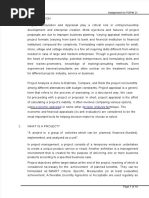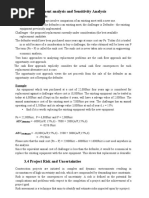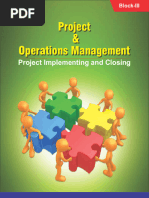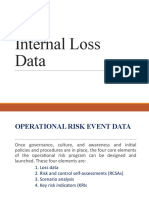0 ratings0% found this document useful (0 votes)
92 viewsAppraisal Criteria
Appraisal Criteria
Uploaded by
Shilpi BansalThis document discusses project appraisal and project management. It covers key aspects of project appraisal including its importance, difficulties, and categories of project sponsors. It also discusses important contracts used in project finance deals. The document outlines the typical project life cycle phases and how uncertainty impacts feasibility estimates over the life cycle. It describes how discounted cash flow valuation and net present value are commonly used to evaluate projects, and also discusses how flexibility can be valued for certain types of projects like R&D.
Copyright:
Attribution Non-Commercial (BY-NC)
Available Formats
Download as PPT, PDF, TXT or read online from Scribd
Appraisal Criteria
Appraisal Criteria
Uploaded by
Shilpi Bansal0 ratings0% found this document useful (0 votes)
92 views6 pagesThis document discusses project appraisal and project management. It covers key aspects of project appraisal including its importance, difficulties, and categories of project sponsors. It also discusses important contracts used in project finance deals. The document outlines the typical project life cycle phases and how uncertainty impacts feasibility estimates over the life cycle. It describes how discounted cash flow valuation and net present value are commonly used to evaluate projects, and also discusses how flexibility can be valued for certain types of projects like R&D.
Copyright
© Attribution Non-Commercial (BY-NC)
Available Formats
PPT, PDF, TXT or read online from Scribd
Share this document
Did you find this document useful?
Is this content inappropriate?
This document discusses project appraisal and project management. It covers key aspects of project appraisal including its importance, difficulties, and categories of project sponsors. It also discusses important contracts used in project finance deals. The document outlines the typical project life cycle phases and how uncertainty impacts feasibility estimates over the life cycle. It describes how discounted cash flow valuation and net present value are commonly used to evaluate projects, and also discusses how flexibility can be valued for certain types of projects like R&D.
Copyright:
Attribution Non-Commercial (BY-NC)
Available Formats
Download as PPT, PDF, TXT or read online from Scribd
Download as ppt, pdf, or txt
0 ratings0% found this document useful (0 votes)
92 views6 pagesAppraisal Criteria
Appraisal Criteria
Uploaded by
Shilpi BansalThis document discusses project appraisal and project management. It covers key aspects of project appraisal including its importance, difficulties, and categories of project sponsors. It also discusses important contracts used in project finance deals. The document outlines the typical project life cycle phases and how uncertainty impacts feasibility estimates over the life cycle. It describes how discounted cash flow valuation and net present value are commonly used to evaluate projects, and also discusses how flexibility can be valued for certain types of projects like R&D.
Copyright:
Attribution Non-Commercial (BY-NC)
Available Formats
Download as PPT, PDF, TXT or read online from Scribd
Download as ppt, pdf, or txt
You are on page 1of 6
MBA-III SEM
Manav Rachna College of Engg.
Project management and
Infrastructure Finance
Project Appraisal
A process of analyzing the technical feasibility and economic
viability of a project proposal with a view to financing their costs.
Importance of project appraisal
– It is a capital investment decision
– It has long term effects
– Decision once taken is irreversible
– Expenditures are high
Difficulties in respect of project appraisal
– Measurement of costs and potential benefits are difficult
– High degree of uncertainty
– Long term spread – time value of money
Contd….
Categories of project sponsors
○ Industrial sponsors
○ Public sponsors with social welfare goals
○ Contractor/sponsors who develop , build and run the plant
○ Pure financial investor
Key contracts used in project finance deals
○ Turnkey construction contract
○ Operations and maintenance contract
○ Purchasers and sales agreement
○ Suppliers and raw material supplies agreement
Project Life Cycle
Conception and selection phase
○ Planning and scheduling phase
○ Implementation, monitoring and control phase
○ Evaluation and termination phase
– Life cycle impact on feasibility Impact on feasibility
○ Uncertainty regarding cost and time estimates in respect of later
stages
○ Estimates need to be adjusted and revised periodically
depending on the lessons leant in the earlier cycles.
○ Typically the focus of project managers is initially on
performance, and then shifts to costs and finally meeting the
deadline. But focus should be on performance fro the beginning
Project Valuation
In general, each project's value will be estimated using a
discounted cash flow (DCF) valuation, and the opportunity with
the highest value, as measured by the resultant net present
value (NPV) will be selected (applied to Corporate Finance by
Manav Rachna College of Engg.
Joel Dean in 1951; see also Fisher separation theorem, John
Burr Williams: theory).
This requires estimating the size and timing of all of the
incremental cash flows resulting from the project. Such future
cash flows are then discounted to determine their Present
Value.
These Present Values are then summed, and this sum net of
the Initial Investment Outlay is the NPV
Valuing Flexibility
In many cases, for example R&D projects, a project may open (or
close) paths of action to the company, but this reality will not
typically be captured in a strict NPV approach.
Management will therefore (sometimes) employ tools which place
an explicit value on these options. So, whereas in a DCF valuation
the most likely or average or scenario specific cash flows are
discounted, here the “flexibile and staged nature” of the
investment ismo d elled, and hence "all" potentialpayo ffs are
considered.
The difference between the two valuations is the "value of
flexibility" inherent in the project.
You might also like
- CJC Jensen Filter - ManualDocument73 pagesCJC Jensen Filter - Manualbrunokfouri40% (5)
- Business Plan On Tender Coconut JuiceDocument16 pagesBusiness Plan On Tender Coconut JuiceSahana Sindya100% (3)
- Estimation and Costing PDFDocument112 pagesEstimation and Costing PDFØwięs MØhãmmed100% (3)
- Integrated Project Planning and Construction Based on ResultsFrom EverandIntegrated Project Planning and Construction Based on ResultsNo ratings yet
- FM - Module 3Document11 pagesFM - Module 3Alok Arun MohapatraNo ratings yet
- PMF PDFDocument14 pagesPMF PDFAKSHAY KATARENo ratings yet
- PM - Unit 4Document12 pagesPM - Unit 4SurendraNo ratings yet
- Chapter 2Document13 pagesChapter 2Gella myka SamsonNo ratings yet
- Unit 5Document24 pagesUnit 5hemanthgiriaNo ratings yet
- Unit 9 Capital Budgeting BBS Notes EduNEPAL - InfoDocument5 pagesUnit 9 Capital Budgeting BBS Notes EduNEPAL - InfoGrethel Tarun MalenabNo ratings yet
- Presentation7 - Evaluating Investment Projects in Mining Industry by CombiningDocument16 pagesPresentation7 - Evaluating Investment Projects in Mining Industry by CombiningRahat fahimNo ratings yet
- Estimation and CostingDocument112 pagesEstimation and Costingjs kalyana rama83% (12)
- Unit 4Document53 pagesUnit 4ankitupatil1No ratings yet
- Construction ContractDocument63 pagesConstruction ContractSuraj KumarNo ratings yet
- 2B Procurement Strategy & Project Delivery SystemsDocument49 pages2B Procurement Strategy & Project Delivery SystemsfunkkataNo ratings yet
- PM Multiple Project and ConstraintsDocument26 pagesPM Multiple Project and Constraintsvalechany9113No ratings yet
- Mar-205 Project Management and Planning: Sunder Deep College of Architecture Submitted By: Rhythm, Aruna, Parit & GauravDocument22 pagesMar-205 Project Management and Planning: Sunder Deep College of Architecture Submitted By: Rhythm, Aruna, Parit & GauravKannha AggarwalNo ratings yet
- Chapter 1Document16 pagesChapter 1Alif MohammedNo ratings yet
- notesDocument7 pagesnotesbangalipizzaNo ratings yet
- Pete 5105: Petroleum Economics and Project Management: ObjectivesDocument23 pagesPete 5105: Petroleum Economics and Project Management: Objectivesboris yeltinNo ratings yet
- u1Document11 pagesu1nidhimhatre55No ratings yet
- Problems in Managing International Projects: Program of IpmDocument7 pagesProblems in Managing International Projects: Program of IpmSiva Naga Aswini BNo ratings yet
- Cup 54Document19 pagesCup 54R00031129No ratings yet
- Capital Budgeting: Meaning Process Project AppraisalDocument15 pagesCapital Budgeting: Meaning Process Project Appraisalhanu11No ratings yet
- Module Name: Procurement and Supply Chain Risk Management Module Code: PLU 08104 Topic No.3Document34 pagesModule Name: Procurement and Supply Chain Risk Management Module Code: PLU 08104 Topic No.3Cymon BravoNo ratings yet
- Construction Life Cycle Pp2Document13 pagesConstruction Life Cycle Pp2Ron JuniorNo ratings yet
- EE&PM Page 9Document6 pagesEE&PM Page 9adityporel609No ratings yet
- Ms 52Document17 pagesMs 52Rishi BawejaNo ratings yet
- Chapter-I: Basic Principles in Engineering Economics 1.1. Quantifying Alternatives For Easier Decision MakingDocument16 pagesChapter-I: Basic Principles in Engineering Economics 1.1. Quantifying Alternatives For Easier Decision MakingAli HassenNo ratings yet
- Assignment Mo PGPM 22Document31 pagesAssignment Mo PGPM 22Saadia KhanNo ratings yet
- Certified Project Finance Analyst (CPFA)Document9 pagesCertified Project Finance Analyst (CPFA)Oroma David FabianoNo ratings yet
- Project Evaluation NotesDocument13 pagesProject Evaluation Notesalok kumarNo ratings yet
- Valuing Management Flexibility:: A Basis To Compare The Standard DCF and MAP Valuation FrameworksDocument19 pagesValuing Management Flexibility:: A Basis To Compare The Standard DCF and MAP Valuation FrameworksWilme NareaNo ratings yet
- Re examiningProjectAppraisalandControlIJPM 01Document9 pagesRe examiningProjectAppraisalandControlIJPM 01puritynanyangwe4No ratings yet
- Project Management 1Document49 pagesProject Management 1Yasir ArafatNo ratings yet
- Chapter-I: Basic Principles in Engineering Economics 1.1. Quantifying Alternatives For Easier Decision MakingDocument22 pagesChapter-I: Basic Principles in Engineering Economics 1.1. Quantifying Alternatives For Easier Decision MakingAli HassenNo ratings yet
- Project Life CycleDocument40 pagesProject Life CycleNurul QamarNo ratings yet
- Chapter 2 - Project Life CycleDocument44 pagesChapter 2 - Project Life Cycleyohannesalemayehu019No ratings yet
- Oaf 624 Course OutlineDocument8 pagesOaf 624 Course OutlinecmgimwaNo ratings yet
- C 2 Methods of Comparing Alternative ProposalsDocument21 pagesC 2 Methods of Comparing Alternative ProposalsAbenezer WondimuNo ratings yet
- Quiz PreparationDocument9 pagesQuiz PreparationDikeledi LekalakalaNo ratings yet
- Fim3701 - Lu2Document44 pagesFim3701 - Lu2Ryan TylerNo ratings yet
- Project Management Case StudyDocument40 pagesProject Management Case Studyvasudev_ny100% (6)
- Project EvaluationDocument20 pagesProject Evaluationquynh.hoang8672100% (5)
- 3.3 Replacement Analysis and Sensitivity AnalysisDocument5 pages3.3 Replacement Analysis and Sensitivity Analysisrobel popNo ratings yet
- UMB - MTS - Chapter 2 Integration Project ManagementDocument44 pagesUMB - MTS - Chapter 2 Integration Project ManagementKartika Sri RahayuNo ratings yet
- Unit I Introduction To Project ManagementDocument20 pagesUnit I Introduction To Project ManagementVairavel ChenniyappanNo ratings yet
- Unit 3 PDFDocument23 pagesUnit 3 PDFRakoon DogNo ratings yet
- Project & Operations ManagementDocument146 pagesProject & Operations Managementkranthi4studiesNo ratings yet
- Yangon Technological University Department of Civil EngineeringDocument28 pagesYangon Technological University Department of Civil Engineeringthan zawNo ratings yet
- SPM - Unit 4 NotesDocument31 pagesSPM - Unit 4 NotesKiran KatragaddaNo ratings yet
- Project:: Dept. of Mechanical Engineering, MMECDocument21 pagesProject:: Dept. of Mechanical Engineering, MMECYogita HulajiNo ratings yet
- ChEg5211 Class 2Document36 pagesChEg5211 Class 2gebremeskel.gang24No ratings yet
- PM0012 - Project Financing & BudgetingDocument7 pagesPM0012 - Project Financing & BudgetingAbhishek JainNo ratings yet
- Group1 Ass#2Document6 pagesGroup1 Ass#2Maritchelle AnduyanNo ratings yet
- Finance NotesDocument6 pagesFinance Notesporal.kisselannNo ratings yet
- Summary and Introduction To Real Options AnalysisDocument7 pagesSummary and Introduction To Real Options Analysisadminprojects1No ratings yet
- 1.7 Project ManagementDocument14 pages1.7 Project Managementsowmiya bNo ratings yet
- PROJECT MONITORING AND EVALUATION- A PRIMER: Every Student's Handbook on Project M & EFrom EverandPROJECT MONITORING AND EVALUATION- A PRIMER: Every Student's Handbook on Project M & ENo ratings yet
- Construction: Handbook for Project Management and Building TechnologyFrom EverandConstruction: Handbook for Project Management and Building TechnologyNo ratings yet
- Handbook of Contract Management for Construction professionals as per FIDICFrom EverandHandbook of Contract Management for Construction professionals as per FIDICRating: 5 out of 5 stars5/5 (1)
- CIV4105 - Assignment 1Document10 pagesCIV4105 - Assignment 1JonathanNo ratings yet
- LESSON PLAN - Business StudiesDocument4 pagesLESSON PLAN - Business StudiesnazianipuNo ratings yet
- CO - ACCT2511 - 1 - 2024 - Term 1 - T1 - in Person - Standard - KensingtonDocument19 pagesCO - ACCT2511 - 1 - 2024 - Term 1 - T1 - in Person - Standard - Kensingtongungnirm915No ratings yet
- Twofold Magazine - Issue 20 - AdvertisingDocument14 pagesTwofold Magazine - Issue 20 - AdvertisingMaryNo ratings yet
- WHU 0-3 CHE West Ham - Chelsea StandingsDocument1 pageWHU 0-3 CHE West Ham - Chelsea StandingslfrdaurmNo ratings yet
- 3rd Year 1st SemesterDocument11 pages3rd Year 1st SemesterSalma SultanaNo ratings yet
- Motor Detroit d13 Con PtoDocument2 pagesMotor Detroit d13 Con PtoingdanielmarroquinNo ratings yet
- Alembic QRGDocument11 pagesAlembic QRGAjayNo ratings yet
- Curs Symfony - EnglezaDocument295 pagesCurs Symfony - EnglezalucianluciNo ratings yet
- Myanmartimes: Well-Trained Terrorists' Behind Meiktila: 88 GenDocument60 pagesMyanmartimes: Well-Trained Terrorists' Behind Meiktila: 88 GenThe Myanmar Times0% (1)
- Chapter Four - Internal Loss DataDocument26 pagesChapter Four - Internal Loss DataaafnanNo ratings yet
- Bluegrass Conspiracy Continues Scratch A Child Support Case and Solve A MurderDocument5 pagesBluegrass Conspiracy Continues Scratch A Child Support Case and Solve A MurderChristopher Alan HigniteNo ratings yet
- Drill Press LatheDocument13 pagesDrill Press Latheboon1961No ratings yet
- MIL STD163C-Notice 1 (Jul 80)Document11 pagesMIL STD163C-Notice 1 (Jul 80)Wyllton CandidoNo ratings yet
- Types of Major Accounts - FABM11Document29 pagesTypes of Major Accounts - FABM11yoreberlyNo ratings yet
- JD CL - CJ4 - 2023 - 1.33.4Document3 pagesJD CL - CJ4 - 2023 - 1.33.4Carlos López-JamarNo ratings yet
- MPSC Mains 2018 Paper 4 GS 2 Question PapersDocument72 pagesMPSC Mains 2018 Paper 4 GS 2 Question Papersdarshan salviNo ratings yet
- ITC in Rural India-Case StudyDocument9 pagesITC in Rural India-Case Studymith_22_nitw100% (1)
- Assignment On LGA.Document9 pagesAssignment On LGA.kenneth kayetaNo ratings yet
- Evaluation of Road Maintenance Priority Using PCI and Road Note 1 For Indonesian District RoadsDocument7 pagesEvaluation of Road Maintenance Priority Using PCI and Road Note 1 For Indonesian District RoadsPercyNo ratings yet
- Microcomputer Architecture (Von Neumann/Princeton)Document7 pagesMicrocomputer Architecture (Von Neumann/Princeton)LorenzoBoyiceNo ratings yet
- Clutch 93 GolfDocument3 pagesClutch 93 Golfpedro.tablet.velosoNo ratings yet
- Seminar Feedback Report Form - Bid RiggingDocument3 pagesSeminar Feedback Report Form - Bid RiggingDarielNo ratings yet
- Fyp 1Document51 pagesFyp 1Tarani TharanNo ratings yet
- Manual of Examination Automation SystemDocument11 pagesManual of Examination Automation SystemSabha NayaghamNo ratings yet
- Source - Nesma Company RegistrarDocument29 pagesSource - Nesma Company Registrarpravinyadav05No ratings yet
- Notification WeboptionsDocument4 pagesNotification Weboptions031 ManikantaNo ratings yet
- User Manual: HAT270A ATS (Automatic Transfer Switch) ControllerDocument13 pagesUser Manual: HAT270A ATS (Automatic Transfer Switch) ControllerVinhNo ratings yet


